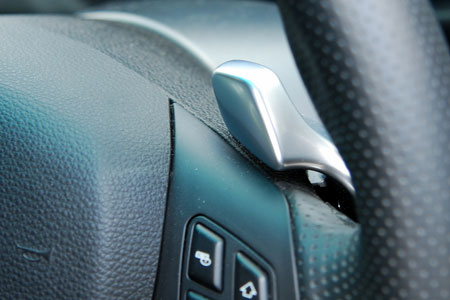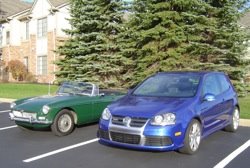
I'll start, of course, with Volkswagen's DSG. The transmission comes with an automatic shift gate with the manual mode selected by pushing the shifter to the right. This, I believe, is the most common execution for a shiftable manual, and it's shared with VW's regular 6-speed slushbox. One difference is the shape of the shifter. Most of VW's automatics come with a T-shaped shifter that is fairly common, and easy to use for the common task of shifting back and forth between park, drive and reverse
 (much of which requires holding down the release button).
(much of which requires holding down the release button).Where this shape is not so satisfying is during manual shifting, where those of us accustomed to manual transmissions like to use a similar grip on a manumatic stalk. For this reason, VW provides a ball-shaped shifter on its sportier DSG applications, including the GTI and R32. I'm a fan.
Next we come to the paddles. I'm quite fond of how VW executes its shift paddles. They're fixed to the back of the steering wheel, with an exposed bit that's labeled + or -.
 This label even lights up at night. Very classy. This execution has also proven very useful during track work, as the paddles will always be at the tips of your fingers during corners, assuming your hands are still at the 9 and 3 positions. For most turns in which you'd need to shift, your hands should still be there, because they'd be fast sweepers. For tighter turns, if you find yourself needing to shift in the middle, it's probably because you missed a downshift as you were braking before the turn started. In that case, you can always fall back on the shift lever, but it may even make you a better driver to learn this lesson.
This label even lights up at night. Very classy. This execution has also proven very useful during track work, as the paddles will always be at the tips of your fingers during corners, assuming your hands are still at the 9 and 3 positions. For most turns in which you'd need to shift, your hands should still be there, because they'd be fast sweepers. For tighter turns, if you find yourself needing to shift in the middle, it's probably because you missed a downshift as you were braking before the turn started. In that case, you can always fall back on the shift lever, but it may even make you a better driver to learn this lesson. This execution is in stark contrast to that of another twin clutch gearbox on the market, Mitsubishi's SST. Mitsubishi has made absolutely certain that everyone knows that their shift paddles are made from magnesium (BMW on the other hand uses magnesium for an actual benefit, that of reduced engine weight). But it is the mounting of these paddles that makes Mitsu's execution really unique. They're affixed to the steering column, meaning they don't move with the wheel. Some people prefer this, but in some spirited driving I did in a Lancer Ralliart yesterday, I firmly established my preference for wheel mounted paddles.
This execution is in stark contrast to that of another twin clutch gearbox on the market, Mitsubishi's SST. Mitsubishi has made absolutely certain that everyone knows that their shift paddles are made from magnesium (BMW on the other hand uses magnesium for an actual benefit, that of reduced engine weight). But it is the mounting of these paddles that makes Mitsu's execution really unique. They're affixed to the steering column, meaning they don't move with the wheel. Some people prefer this, but in some spirited driving I did in a Lancer Ralliart yesterday, I firmly established my preference for wheel mounted paddles. The one area where I do prefer Mitsubishi's layout is the shift lever. It actually looks and feels like a true stickshift lever, and its shift layout is opposite to that of the VW. To engage manual mode, you pull it to the left, so it's closer at hand, and you pull it back to upshift and push forward to downshift. To some this is counterintuitive, but to a true stickshift driver, this is exactly how it should be, mimicking the way a direct throw backward in a manual is always a higher gear.
The one area where I do prefer Mitsubishi's layout is the shift lever. It actually looks and feels like a true stickshift lever, and its shift layout is opposite to that of the VW. To engage manual mode, you pull it to the left, so it's closer at hand, and you pull it back to upshift and push forward to downshift. To some this is counterintuitive, but to a true stickshift driver, this is exactly how it should be, mimicking the way a direct throw backward in a manual is always a higher gear. BMW also agrees in this regard, as they've been laying out their manumatics this way for years. Where BMW falls flat is in their steering wheel paddles. The Bavarians believe that you should be able to upshift or downshift with either hand, and it's a solid idea, until you come upon their solution for this. Each paddle in a Bimmer can be pulled with the fingers (for an upshift) or pushed with the thumb (for a downshift). While this does feel inherently intuitive, especially as it matches up with the shift lever, its downfall is in the thumb activation. When your hands are in a natural driving position, a yank on a paddle is natural and easily executed. But as I found in the X6 I drove yesterday, the downshift was another story, especially during spirited driving. The thumb extension felt strained and awkward, twisting my wrists into unnatural positions. You may think this is nitpicky and stupid, and I'll admit that I'm the prince of piddling pet peeves, but it did make me feel less in control and legitimately reduced my enjoyment of the drive.
BMW also agrees in this regard, as they've been laying out their manumatics this way for years. Where BMW falls flat is in their steering wheel paddles. The Bavarians believe that you should be able to upshift or downshift with either hand, and it's a solid idea, until you come upon their solution for this. Each paddle in a Bimmer can be pulled with the fingers (for an upshift) or pushed with the thumb (for a downshift). While this does feel inherently intuitive, especially as it matches up with the shift lever, its downfall is in the thumb activation. When your hands are in a natural driving position, a yank on a paddle is natural and easily executed. But as I found in the X6 I drove yesterday, the downshift was another story, especially during spirited driving. The thumb extension felt strained and awkward, twisting my wrists into unnatural positions. You may think this is nitpicky and stupid, and I'll admit that I'm the prince of piddling pet peeves, but it did make me feel less in control and legitimately reduced my enjoyment of the drive.I also got to drive the new Cadillac CTS-V. Fantastic car, but its shift setup was not ideal. Not only was the shifter laid out with forward upshifts, but the paddles were not visible behind the wheel. They were basically just buttons on the backs of the wheel spokes, and if you weren't feeling around for them, you wouldn't know they're there. They also offer less surface area than other paddles, making them less accessible.
I think the variety of executions throughout the industry makes for interesting reinforcement of brand character. Mitsubishi's setup reflects the raw nature of its performance cars, whereas VW executes the system in a highly refined way. But some systems just work better than others, and clearly my ideal setup for a shiftable automatic would be the VW paddles with the Mitsubishi lever. Manufacturers take note!


No comments:
Post a Comment